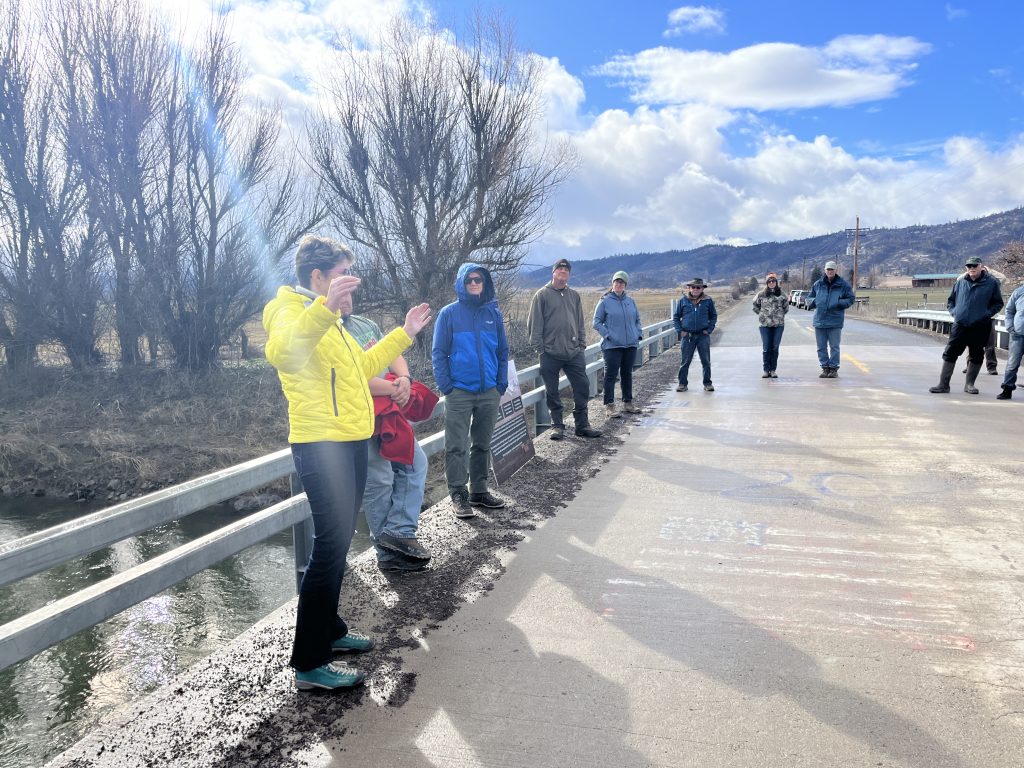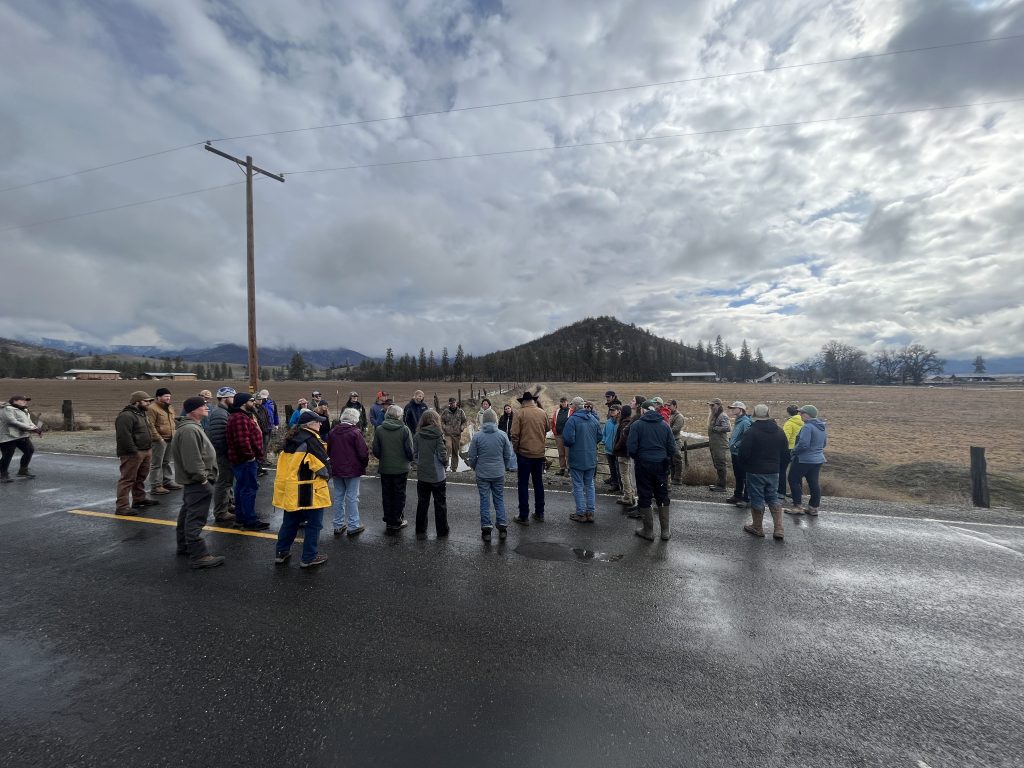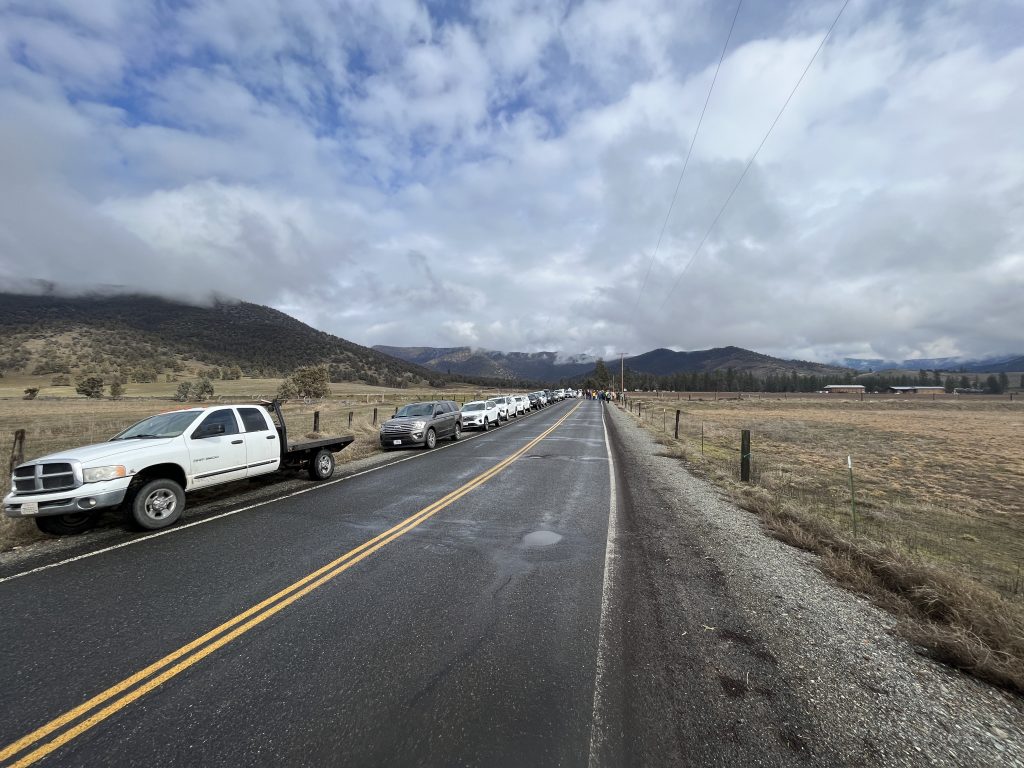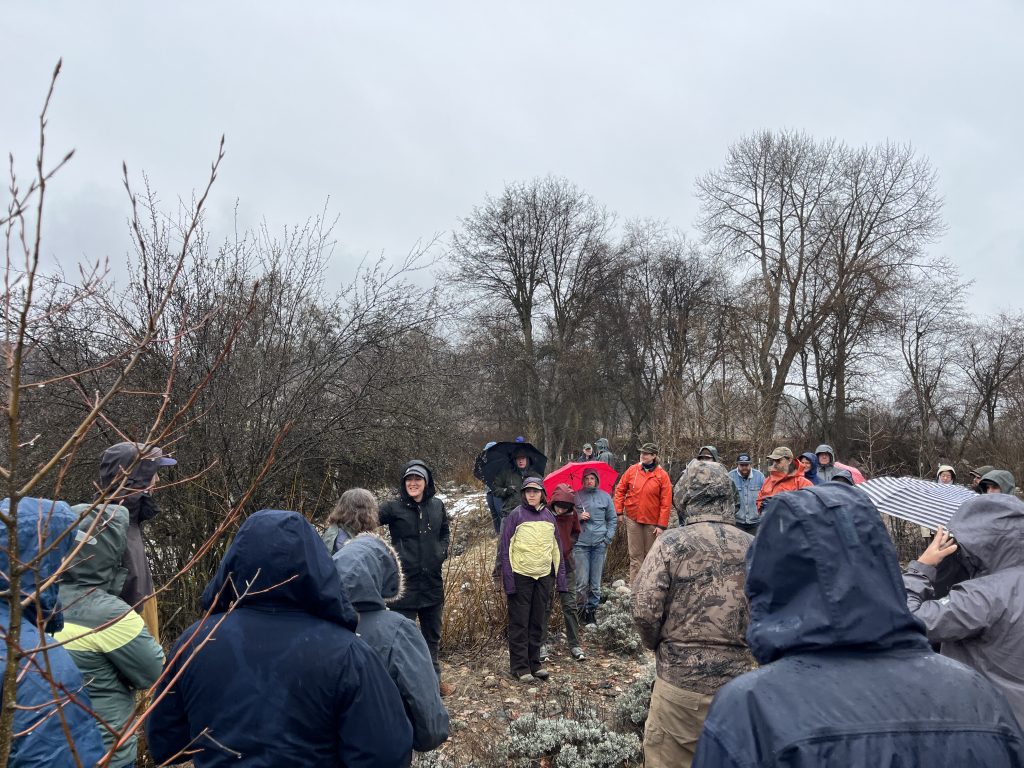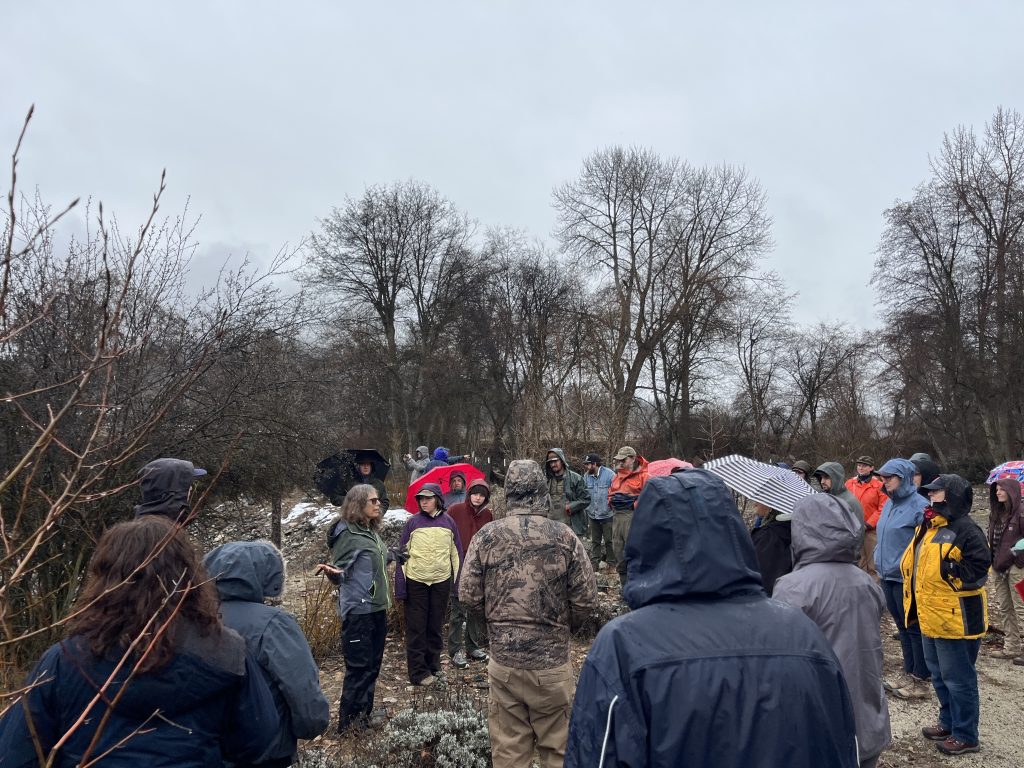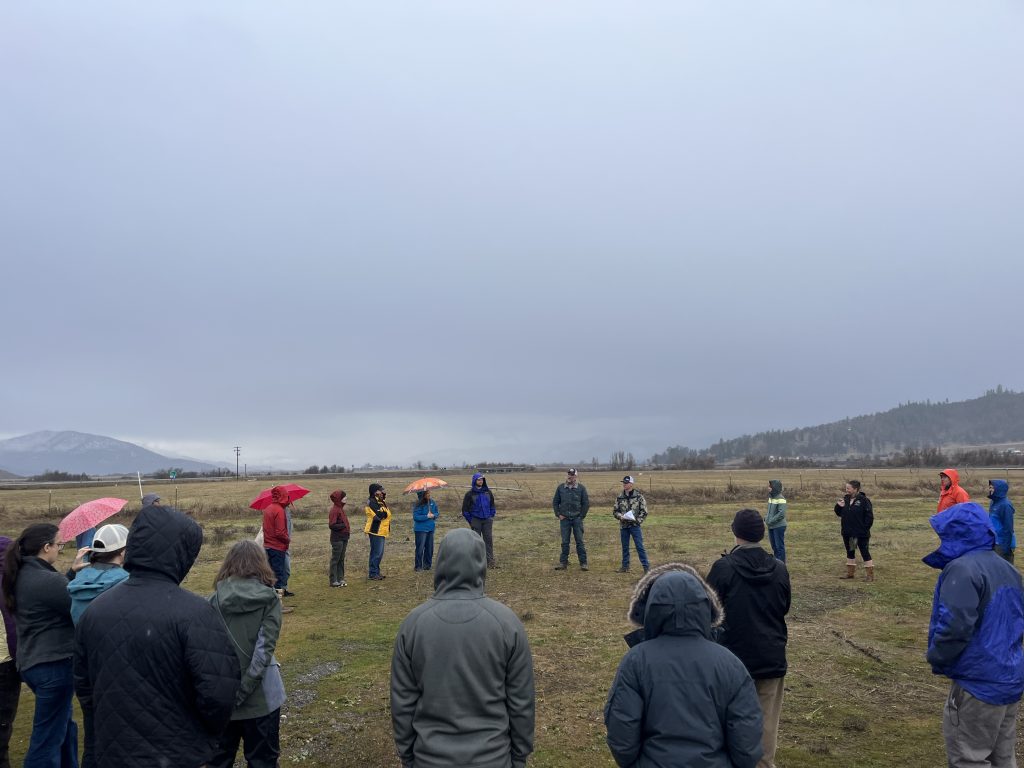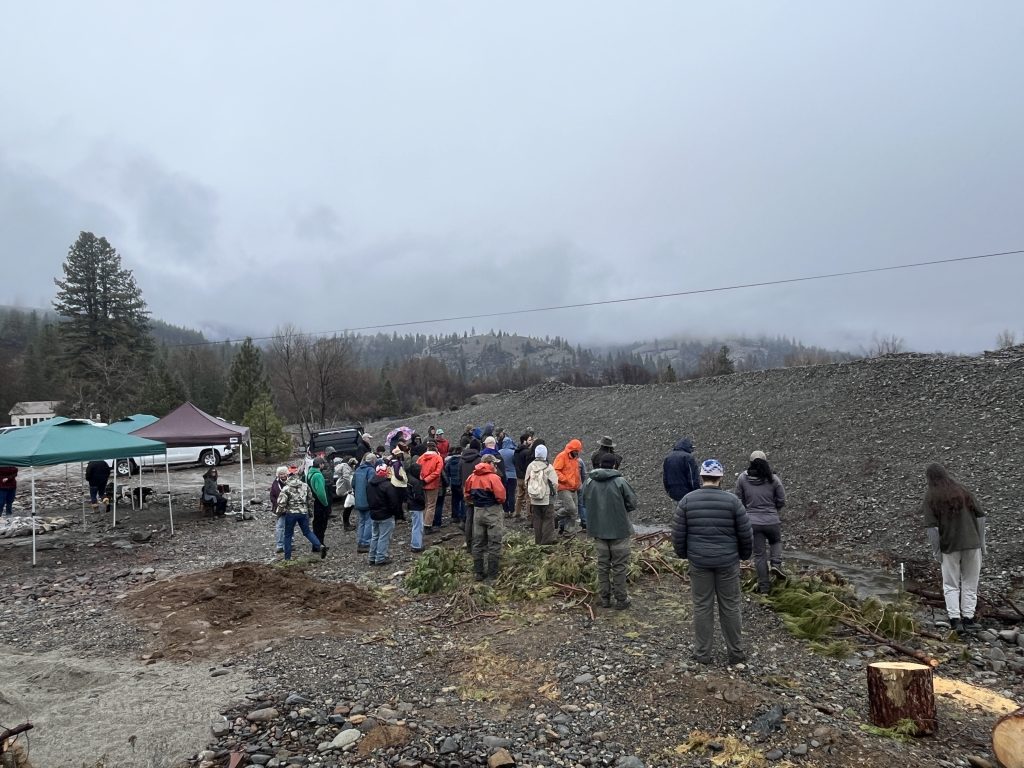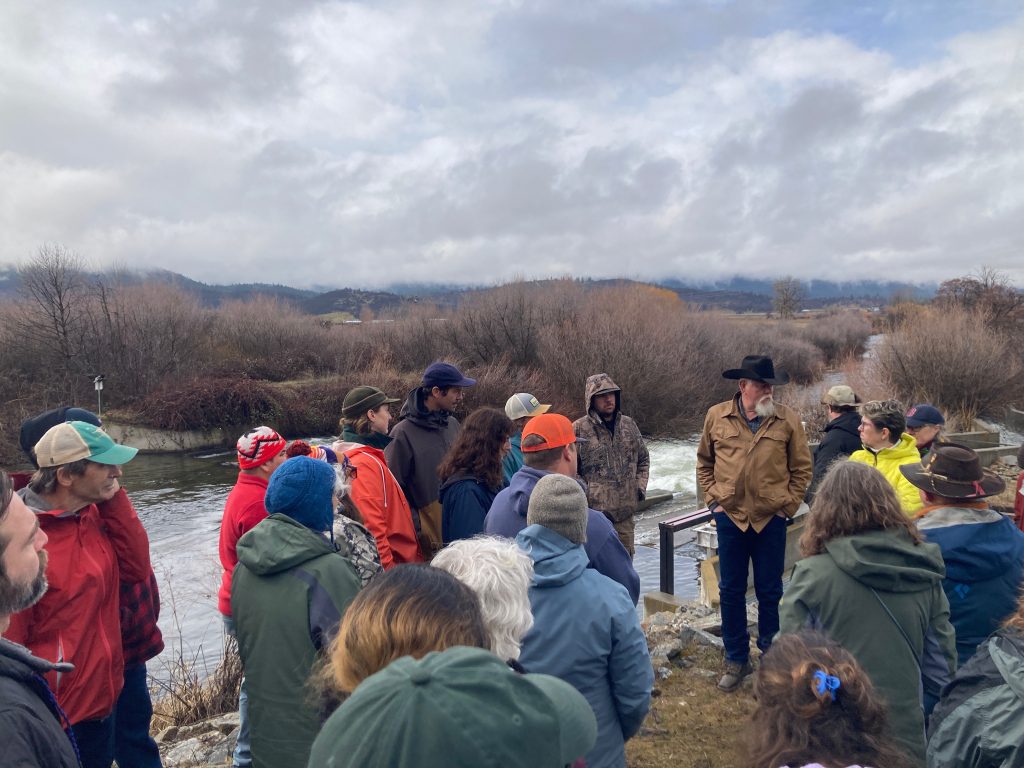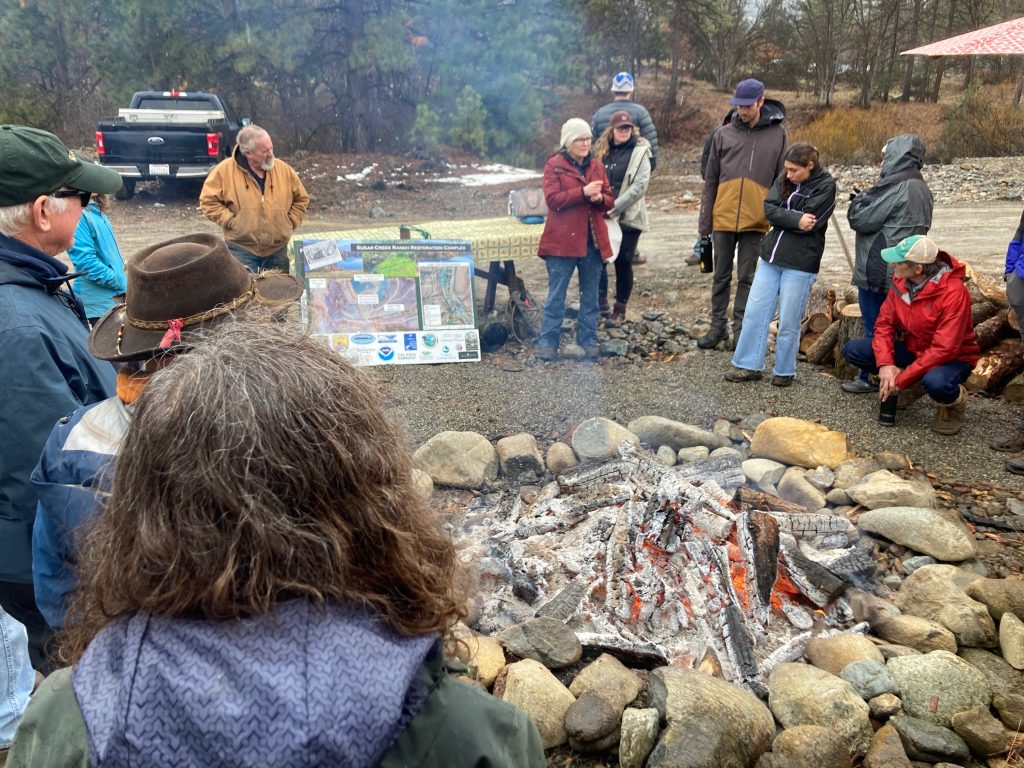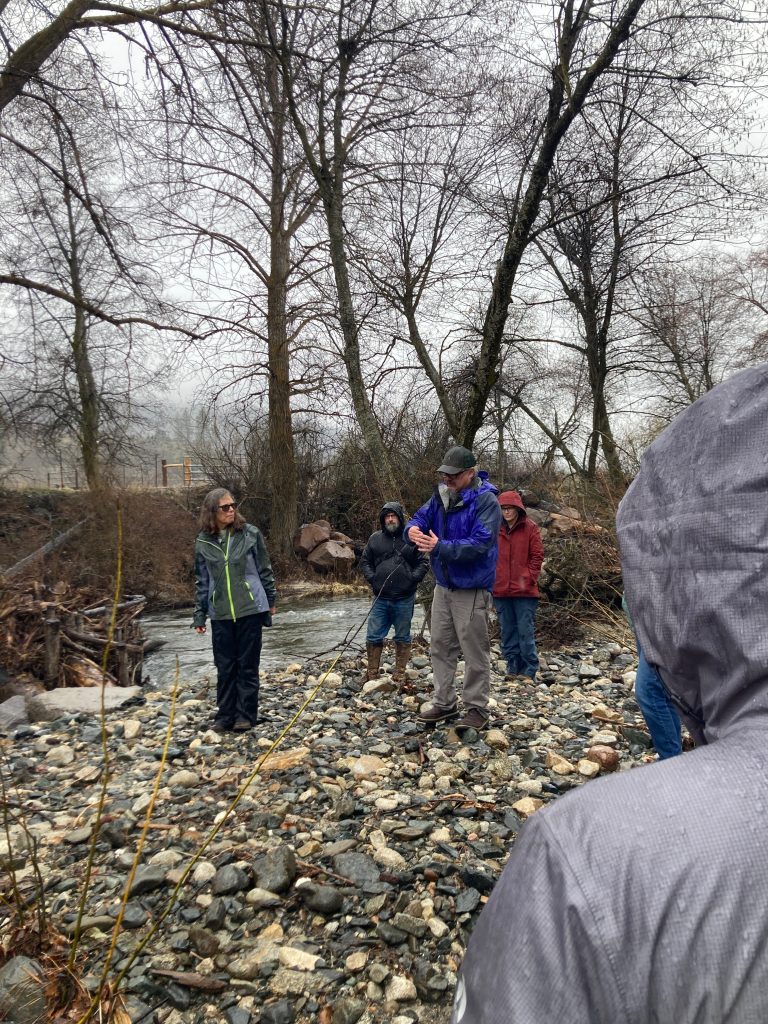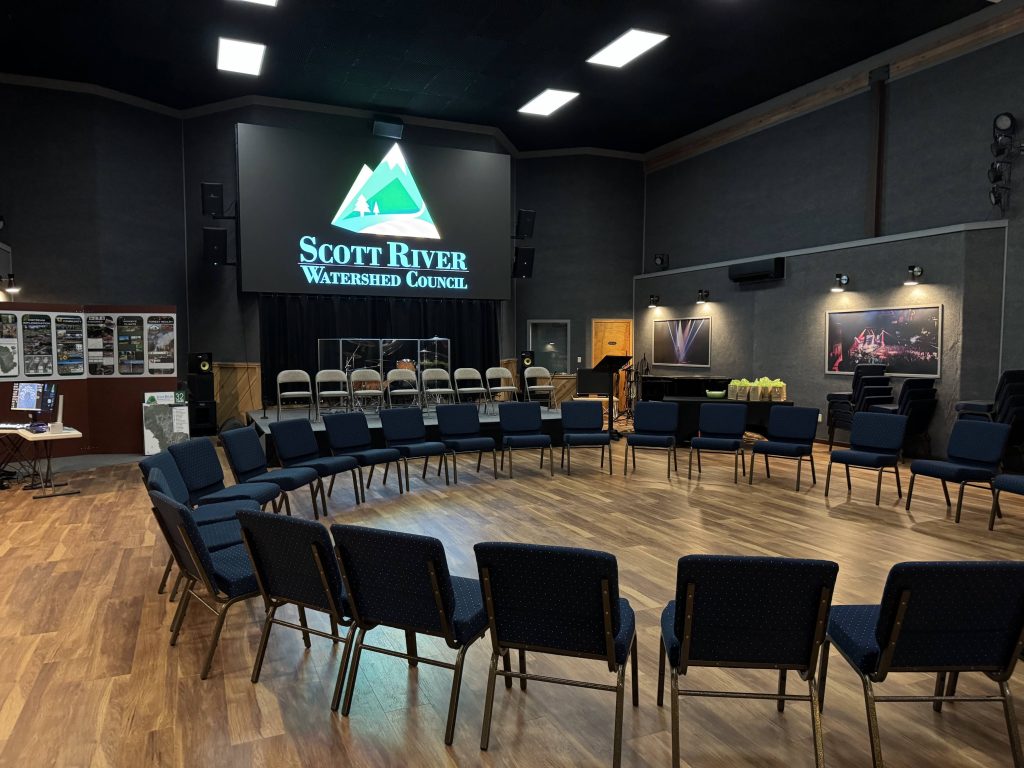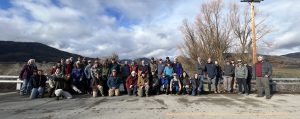For those not able to join us for SWIF 2025, there was great information shared and a lot of great conversation around important issues in the Scott River watershed and Klamath Basin as a whole. Some general feedback was received from the event’s survey along with suggestions for next year!

Below is the list of presentations for both days, along with the powerpoint and video. Please note, not all presenters had a presentation and there were several videos not included due to some technical difficulties.
Thursday, February 20, 2025 – Scott Watershed Informational Forum
Advancing Monitoring Networks in the Scott Valley Watershed: a collaborative successful effort – Dr. Laura Foglia, Larry Walker and Associates: Presentation Video of Presentation
Multiple agencies maintain monitoring networks in the Scott Valley watershed, for water management, habitat restoration, and water allocation. These agencies coordinate and collect data such as: precipitation, streamflow, groundwater levels, and water quality. While network expansion has occurred under the Sustainable Groundwater Management Act (SGMA), additional monitoring stations are planned for ET, soil moisture, and tributary inflows. Maintenance of the monitoring networks is critical for establishing a historical record while the watershed works toward sustainability.
Status and Trends of Adult Chinook Salmon and Coho Salmon in the Scott River – Morgan Knechtle, California Department of Fish and Wildlife: Presentation Video of Presentation
This presentation will focus on the status and trends of Adult Chinook Salmon and Coho Salmon escapement in the Scott River. There will be a brief overview of the methods used to generate these estimates. The data presented for Chinook Salmon will be from the years 1978- 2023 and the Coho Salmon data presented will be from 2007-2023. Preliminary data from the 2024 season will be discussed. Current trends in abundance will be presented annually and by brood year. These adult data will be compared to the number of juveniles produced by cohort to evaluate in-river and out of basin productivity.
Scott River Watershed Council’s Fisheries Monitoring Program – Erich Yokel, Scott River Watershed Council: Presentation Video of Presentation
The SRWC’s Fisheries Monitoring Program is a collaborative initiative between the Scott River Watershed Council (SRWC) and the Quartz Valley Indian Reservation (QVIR). This program aims to enhance ongoing efforts to document juvenile and adult coho salmon (Oncorhynchus kisutch) populations within the Scott River and its tributaries. By integrating with broader monitoring and research efforts throughout the basin, this work provides critical data to inform fisheries and water management decisions while guiding future habitat restoration activities. This presentation will highlight this integrated effort and how SRWC is working to understand how the restoration efforts are impacting the Scott River coho salmon.
Thinking Comprehensively: A Whole Watershed Approach to Restoration Planning on French Creek – Betsy Stapleton, Scott River Watershed Council: Presentation Video of Presentation
The French Creek Watershed contains the “Miracle Mile” (one square mile with the highest number of different conifer species in the world), might be the most productive coho spawning and rearing stream in California, and supports agriculture and other human uses. Restoration planning to enhance and protect all of these needs requires a holistic and comprehensive approach. The Scott River Watershed Council has assembled a broad team of landowners, experts, Tribes and agencies to undertake a whole watershed approach to restoration planning. Learn about our approach in this session and how our past successes are going to inform an expanded effort.
Siskiyou County Drought Plan – Strategies for Resilience – Bryan Schenone, Siskiyou County Director of Emergency Services: Presentation Video of Presentation
Siskiyou County faces increasing challenges from prolonged drought conditions, impacting local communities, agriculture, and natural ecosystems. This presentation will explore the Siskiyou County Drought Plan, a comprehensive strategy designed to enhance water conservation, improve drought preparedness, and promote long-term resilience. We will discuss the historical and current drought patterns in the region, key factors influencing water availability, and the critical role of monitoring and early warning systems. Additionally, the presentation will outline essential water management strategies, including sustainable groundwater use, irrigation efficiency improvements, and emergency response measures. Collaboration is vital in addressing drought-related challenges, and we will highlight the partnerships between local agencies, tribal governments, conservation groups, and state and federal programs. Through proactive planning, innovative solutions, and community engagement, Siskiyou County is working toward a more sustainable and resilient future. Join us to learn how the Siskiyou County Drought Plan aims to mitigate drought impacts and how individuals, businesses, and policymakers can contribute to water conservation efforts.
MORNING SESSION PANEL DISCUSSION VIDEO
Scott River Recovery Action Plan Project (SRRAPP) – Charnna Gilmore, Scott River Watershed Council: Presentation Video of Presentation
Why hasn’t the Scott River’s channelization, confinement, and incision, which are the fundamental drivers of the loss of groundwater, in-stream flow, and associated habitat, been addressed to date? For decades the required scale of the restoration, and the social and economic complexity in achieving it, have been daunting and overwhelming barriers. However, with climate change, drought, regulatory, and economic pressures there is increasing recognition that now is the time to “Go big or go home” if we are to have any chance of warding off extirpation of species and the loss of human communities.
The Scott River Recovery Action Plan Project is working to integrate and make actionable existing restoration and management plans and prioritizations with a comprehensive geophysical and economic analysis, regulation issues and community engagement to achieve landscape scale recovery of the Scott River’s ecological function. Over the past several years, a committee of people, all interested in seeking meaningful solutions, have been meeting quarterly to begin work on developing a cooperative and comprehensive recovery plan for the basin. By bringing people from all sectors of our community to develop this plan we feel there will be a stronger chance of maintaining the Valley’s social and resource based economic cohesion, which, in the long run, will result in improved and sustainable outcomes.
Decision-Making for a Resilient Future for Scott Valley – Jennie Hoffman, Adaptation and Insight: Presentation Video of Presentation
Jennie is working with the Scott River Recovery Action Plan Project team to develop effective decision- making processes that accounts for more than analyzing physical and financial factors. This presentation will explore a structured approach to decision-making that highlights underlying values, perspectives, and trade-offs often overlooked in traditional planning. By integrating diverse stakeholder input, this process aims to enhance understanding, foster inclusive dialogue, and facilitate the negotiation of risks and tradeoffs associated with future actions. The approach encourages creative problem-solving to develop solutions that align with community values while addressing complex challenges such as climate adaptation, resource management, and sustainability. Join us to discover how decision-making criteria can help communities navigate uncertainty, strengthen resilience, and create strategies that are both practical and equitable.
Upland Management and Precipitation-Runoff Modeling System in Scott Valley – Dr. Laura Foglia, Larry Walker and Associates Presentation Video of Presentation
Multiple studies have demonstrated that targeted plant removals, controlled burns, and other activities occurring on the uplands of a watershed have the potential to profoundly impact downstream flow. However, the extent and nature of these effects are site specific, and the specific implications for streamflow in Siskiyou County watersheds remain largely unexplored. Of particular interest is the Scott River due to its important role as both a tributary of the Klamath River and a habitat for endangered salmon species. To better understand streamflow and upland recharge contributions in the valley, a Precipitation-Runoff Modeling System (PRMS) was constructed to estimate runoff and streamflow in the entire Scott Valley Watershed. The PRMS model was designed to provide improved modeled the Scott Valley Integrated Hydrologic Model (SVIHM), a MODFLOW-based groundwater model.
SVIHM is used by the local groundwater sustainability agency (GSA) of the Scott Valley groundwater basin for groundwater sustainability plan (GSP) implementation. The GSA and stakeholders are interested in upland management projects as a mechanism to sustainably manage the groundwater basin. Upland management scenarios for meadow restoration, juniper removal, and wildfire have been run using the Scott Valley PRMS model. To ensure model outputs match real watershed responses, statistical relationships between streamflow and precipitation were compared before and after a large wildfire in the South Fork watershed. Wildfires were chosen as a sufficient proxy for human driven upland management due to their occurrence at single points in time, measurable vegetation impacts, and well-mapped extents. Both analyses demonstrate the impact of upland management on streamflow, ET, recharge, and groundwater baseflow. Results will be used to enhance the monitoring network to better characterize impact/benefit of different management activities.
Building Blocks of the Scott River Recovery Action Plan Project (SRRAPP): The Hydrogeomorphic Study – April Sawyer and Dr. Scott Wright, CBEC Eco Engineering, A Verdantas Co. Presentation Video of Presentation
A comprehensive chronology of the natural- and human-caused fluvial geomorphic events, processes, and drivers is needed to provide context to today’s river conditions along the mainstem Scott River and its tributaries. The Scott River has been channelized, leveed, and straightened, which has reduced channel complexity. These actions have likely impacted lateral, longitudinal, and vertical connectivity with floodplains, groundwater availability, and timing of baseflows, as well as the quantity and quality of habitat for various life stages of anadromous salmonids and Pacific lamprey. Additionally, the timing, amount, and location of sediment deposition and erosion, which can affect surface water-groundwater connectivity as well as habitat conditions, are poorly understood. Thus, the reach-scale and system-wide impacts of localized recovery actions are often poorly defined and could lead to unintended outcomes or maintenance concerns. The Hydrogeomorphic Study component of the Scott River Recovery Action Plan Project (SRRAPP) intends to evaluate the watershed-wide hydrologic and geomorphic processes and sediment routing patterns, and augment Larry Walker and Associates’ (LWA) Scott Valley Integrated Hydrologic Model. By coupling LWA’s hydrologic and groundwater modeling tools with system-wide hydraulic and sediment transport models of the mainstem Scott River, we will assess existing conditions of channel hydraulics, surface water-groundwater interactions, and sediment transport patterns. We aim to identify and prioritize specific restoration actions that consider watershed-wide sediment conditions and hydraulic connectivity by overlaying the geomorphic process assessment with the coupled groundwater-surface water models and an understanding of habitat, fish, and agricultural utilization. This pillar of the SRRAPP will provide detailed information to support the development of a comprehensive, holistic river action plan with prioritized recovery actions and identified benefits and challenges. We will integrate and leverage multiple existing planning and design efforts into the larger watershed setting to gain momentum toward a project implementation phase of SRRAPP-identified actions.
Demand for and Value of Water in the Scott River Watershed – Dr. Mark Buckley, ECOnorthwest Presentation Video of Presentation
ECOnorthwest has been working with SRWC and SRRAPP to assess the demand and economic value of water within the Scott River Watershed. Specifically, the analysis focuses on estimating the current values of agricultural production, salmon populations, recreation, and cultural and tribal values supported by the Scott River within the watershed. The analysis estimates the value for current conditions and discusses the expected trajectory of these values under a Business-As-Usual Scenario i.e. in the absence of a Scott River Recovery Action Plan. ECOnorthwest will share findings from their analysis.
AFTERNOON SESSION PANEL DISCUSSION VIDEO
Friday, February 21, 2025 – Community Resilience through Health Forest Initiative Summit
Molly Breitmün – Moderator – Welcome
Boots on the Ground – The key to protecting the things we cherish – Nadine Bailing, Family Water Alliance, Inc. Video of Presentation
Family Water Alliance Inc. and Jefferson Resources are excited to be a part of the effort by Cal Fire to reduce the impacts of climate change on local communities, by reducing the fuel load and cleaning up after recent fires. The Weed Community Forest and Restoration Project will focus on forest health and resiliency by restocking forests to establish strong environments capable of surviving future wildfire, endemic, and exotic pests, drought and temperature fluctuations. The project will take place in the footprint of the Boles and Mill fires in Siskiyou County and will allow the public to see that there are measures that can be taken to reduce the hazards of fire. This is a unique partnership that underscores the importance of a healthy watershed to fish and farms as well as communities. The location next to Interstate 5 will give us some excellent opportunities to talk about the benefits of fuel reduction to the health and future of our forests.
Siskiyou Prescribed Burn Association – Patty Grantham, Siskiyou Prescribed Burn Coordinator Presentation Video of Presentation
Update on the Siskiyou Prescribed Burn Association – 2024 progress and 2025 plans
Meadow Restoration in the Scott Watershed – Meagan Ireson, Scott River Watershed Council Presentation Video of Presentation
Functional mountain meadows provide important ecosystem services such as moderating stream flow and sediment, decreasing downstream erosion and flooding, storing carbon and providing habitat for a diverse range of plants and animals. Additionally, they are traditionally utilized by indigenous tribes for both basket weaving materials and medicinal plants. Recognizing the value that meadows have on the Scott River, and the history of human impacts that have damaged meadow systems, the Scott River Watershed Council is expanding our work in mountain meadows. Through ongoing monitoring, hydrologic restoration, and conifer removal in meadows, SRWC collaborates with public and private partners to restore degraded meadows across the watershed.
We can have frogs and catch fish too: reversing widespread legacy impacts of introduced sportfish on declining amphibians in glacial lake basins of the Klamath Mountains – Justin Garwood, California Department of Fish & Wildlife Presentation Video of Presentation
The high mountains of the Klamath Range have been dramatically shaped by ancient glaciers which left behind hundreds of natural historically fishless lakes, thousands of ponds, and extensive networks of peatland meadows. These unique high-elevation wetlands host distinct wetland communities found nowhere else in the region. Cascades Frogs are an aquatic breeding amphibian that strictly inhabit high-elevation wetlands of the Klamath Mountains and the Cascades Range in Northern California and populations have been declining for decades. The Cascades Frog is a California Species of Special Concern and is currently a candidate species pursuant to the California Endangered Species Act. Three dominant risk factors include introduced predatory salmonid fishes, recent outbreaks of the fungal pathogen Batrachochytrium dendrobatidis (i.e. chytrid fungus) and habitat alteration and desiccation through climate change. Because introduced trout occupy only permanent waters, amphibians often overlap with this predator when axillary shallow waters dry up.
To combat these threats, California Department of Fish and Wildlife (CDFW) changed their fish stocking policies nearly a decade ago by ceasing stocking waters that contained Cascades Frogs until an inventory of fish and amphibian populations could be completed. This management shift has reduced trout population distributions, especially in small shallow lakes. Based on an extensive survey from 2021 to present, CDFW is now actively managing trout populations through a multi criteria decision analysis where fishery quality and amphibian resilience are measured for each site. A lake restoration project was initiated in 2023 to remove Brook Trout in several small lakes that are important to Cascades Frog persistence but are also not considered high-value fisheries. This talk will provide an update on our amphibian and fish population inventories, our lake restoration progress, and the status and direction of our existing trout fisheries.
East Fork of the Scott River Forest Management – Chris Gentry, Scott River District, Klamath National Forest Presentation Video of Presentation
The East Fork Scott River Project is a long-term effort aimed at improving forest health, watershed resilience, and wildfire risk reduction in the Scott River Basin. Chris will discuss the strategic approach taken this year to reduce hazardous fuels, enhance wildlife habitat, and promote sustainable forestry practices. The presentation will include an assessment of treated acres, the effectiveness of thinning and prescribed fire treatments, and the role of meadow restoration in supporting water retention and biodiversity. Additionally, any other significant restoration work completed this year will be highlighted.
Beyond the 2024 season, the presentation will offer a comprehensive project overview, tracing its progress since inception and illustrating how past efforts have shaped its current success. Looking forward, Chris will discuss future projects, including planned treatments, continued habitat enhancements, and collaborative efforts to maintain and expand the project’s impact.
Scott River Watershed Council Forest Health Projects – Dane Rosele, Scott River Watershed Council Presentation Video of Presentation
The health of our forests is integral to the well-being of the entire watershed ecosystem. This presentation will highlight the Scott River Watershed Council’s ongoing efforts to restore and maintain forest health in the Scott River Watershed. We will delve into the importance of forest management practices that reduce wildfire risk, enhance habitat for wildlife, and improve water quality.
Topics will include collaborative restoration projects, such as forest thinning and prescribed burns. Working with landowners to emphasizes the connection between forest health, watershed resilience, and the long-term sustainability of our natural resources. Through community partnerships and scientific research, we strive to create a balanced approach to forest stewardship that benefits both the environment and local communities.
Uneven-aged Forest Management: Effects on species composition & stand health – Cole Humphrey, Hearst Forests Presentation Video of Presentation
Uneven-aged forest management is the most common management strategy for small forest landowners throughout the U.S. However, is this management strategy conducive to the current risk of intense fire behavior or potential forest pathogens impacting these landowners? We will be reviewing what is uneven-aged silviculture, uneven-aged forest structure, deviations from historic forest structures, regulatory and economic considerations, and impacts on fire behavior and forest health.
MORNING SESSION PANEL DISCUSSION VIDEO
